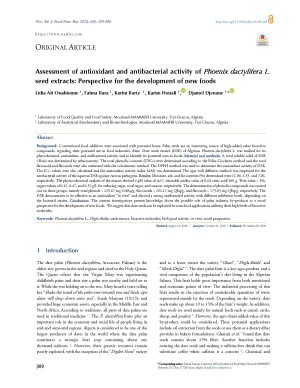Assessment of antioxidant and antibacterial activity of Phoenix dactylifera L. seed extracts: Perspective for the development of new foods
Abstract
Background: Conventional food additives were associated with potential harm. Palm seeds are an interesting source of high-added value bioactive compounds, regarding their potential use in food industries. Aim: Date seeds extract (DSE) of Algerian Phoenix dactyliefra L. was studied for its phytochemical, antioxidant, and antibacterial activity and to identify its potential uses in foods. Material and methods: A total soluble solid of DSE (°Brix) was determined by refractometry. The total phenolic contents (TPCs) were determined according to the Folin-Cioclateu method and the total flavonoid and flavonols were also estimated with colorimetric method. The DPPH method was used to determine the antioxidant activity of DSE. The IC50 values were also calculated and the antioxidant activity index (AAI) was determined. The agar well diffusion method was employed for the antibacterial activity of the aqueous DSE against various pathogens. Results: Moisture, ash, and fat contents (%) determined were 11.06, 1.33, and 7.06, respectively. The physicochemical analysis of the extract showed a pH value of 4.67, titratable acidity value of 0.64 citric acid/100 g, °Brix value = 3%, sugars values of 0.12, 0.47, and 0.35 g/L for reducing sugar, total sugar, and sucrose, respectively. The determination of phenolic compounds was carried out on three groups, namely total phenols = 229.67 mg GAEq/g, flavonoids = 201.12 mg QEq/g, and flavonols = 173.03 mg QEq/g, respectively. The DSE demonstrates to be effective as an antioxidant “in vitro” and showed a strong antibacterial activity with different inhibition levels, depending on the bacterial strains. Conclusion: The current investigations present knowledge about the possible role of palm industry by-products as a novel perspective for the development of new foods. We suggest that date seeds can be exploited in some food applications utilizing their high levels of bioactive molecules.
Full text article
Authors
Copyright (c) 2020 Authors

This work is licensed under a Creative Commons Attribution 4.0 International License.
-
Attribution — You must give appropriate credit, provide a link to the license, and indicate if changes were made. You may do so in any reasonable manner, but not in any way that suggests the licensor endorses you or your use.
-
No additional restrictions — You may not apply legal terms or technological measures that legally restrict others from doing anything the license permits.





